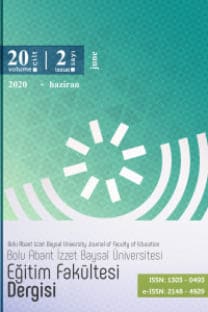Teachers' Point of Views on Affective Domain Applications in the Secondary Elemantary Schools
Teachers' Point of Views on Affective Domain Applications in the Secondary Elemantary Schools
Teachers’ affective domain applications in the junior high schools were explored in this study. 131 junior high school teachers participated in the study. They were selected randomly from 465 schools in central Ankara. Teachers answered a 57-item questionnaire. Ten of the teachers were interviewed based on the questionnaire items used for the study. Differences among teachers were studied according to years of teaching experience, amount of pedagogical units taken during the teacher training, and familiarity levels of affective domain taxonomies. Group differences were evaluated by performing t tests and analyses of variance (ANOVA). Results showed that there was a significant difference between the teachers who took different levels of pedagogical units. On the other hand, more experienced teachers in years of teaching did not show significant difference then the less experienced teachers. Moreover, being familiar with affective domain taxonomies did not show statistically significant difference. The implications of the findings are discussed.
___
- Anderson, L. W. (1981). Assessing affective characteristics in the schools. Boston: Allyn and Bacon.
- Martin B. L. (1989) A checklist for designing instruction in the affective domain. Educational Technology 29(August), 7-15.
- Bloom, B. S. (Ed.) (1956). Taxonomy of educational objectives: The classification of educational Goals. handbook I: Cognitive domain. New York: Longman, McKay.
- Byrne, B. (1984). The general/academic self-concept nomological network: A review of construct validation research. Review of Educational Research, 54, 427-526.
- English, H. B., & English, A. C. A. (1958). Comprehensive dictionary of psychological and psychoanalytical terms. New York: Longman, Green.
- Eysenck, H. J., Arnold, W., & Meili, R. (1972). Encyclopedia of psychology. Vol. 1, A to F. New York: Herder and Herder.
- Krathwohl, D. R., Bloom, B. S., Masia, B. B, (1964). Taxonomy of educational objectives: The classification of educational goals. Handbook II: Affective domain. McKay, NY: Longman.
- Martin, B. L., (1989). A checklist for designing instruction in the affective domain. Educational Technology, 29, 7-15.
- Raths, L. E., Harmin, M., & Simon S. B. (1966). Values and teaching: Working with values in the classroom. Columbus, OH: Merrill
- Reigeluth, C. (1983). Instructional-design theories and models: An overview of their current status. Hillsdale, NJ: Lawrence Erlbaum.
- Rompelman, L. (2002). Affective teaching. Lanham, Maryland: University Press of America.
- Sinclair, K. E., (1985). Student's affective characteristics and classroom behavior. The international encyclopedia of education. Oxford, England: Pergamon.
- Snow, R. (1987). Aptitude complexes. In R. Snow & M. Farr (Eds.), Aptitude, learning and instruction, cognitive process analyses of aptitude (Vol. 3, pp. 11-34). Hillsdale, NJ: Erlbaum.
- Snow, R., and Farr, M. (1987). Aptitude complexes. In R. Snow & M. Farr (Eds.), Conative and affective process analysis (Vol. 3, pp. 11-34). Hillsdale, NJ: Erlbaum.
- Snow, R. (1989). Aptitude-treatment interaction as a framework for research on individual differences in learning. In P. Ackerman, R. J. Sternberg, & R. Glaser (ed.), Learning and individual differences. New York: Freeman.
- Snow, R. E. & Swanson, J. (1992). Instructional psychology: Aptitude, adaptation, and assessment. Annual Review of Psychology, 43, 583-626.
- Travers, R. M. R. (Ed.). (1973). Second handbook of research on teaching. Chicago: Rand McNally.
- 2001 Yili başinda milli eğitim. Retrieved December 15, 2002, from http://www.meb.gov.tr/Stats/ist2001/Bolum5s3.htm#g14
- Warren H. C. (1934). Dictionary of psychology. Boston: Houghton Mifflin.
- ISSN: 1303-0493
- Yayın Aralığı: 4
- Başlangıç: 2000
- Yayıncı: Abant İzzet Baysal Üniversitesi Eğitim Fakültesi
